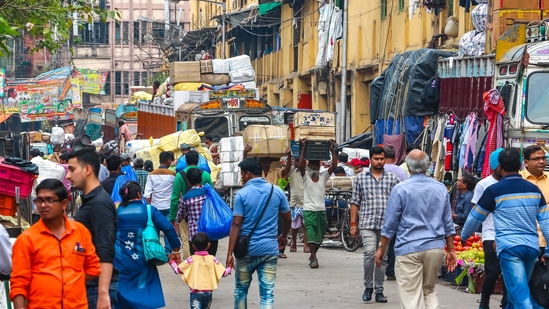Indians now spend more time at work than at rest
In 2024, Indians spend more time on work and entertainment but less on self-care compared to 2019, indicating increased work and caregiving demands.
On average, Indians spent more time on work, entertainment, and unpaid caregiving services in a day in 2024 than in 2019. This mostly came at the expense of time they used to spend in 2019 on self-care and maintenance (a broad official term encompassing everything from sleeping to receiving medical care), but they also cut down the time spent on nearly every other category of daily activities.

The trends in daily time use are the summary results of the Time Use Survey (TUS) conducted in January-December 2024 by the National Statistics Office (NSO) across 139,487 households, a factsheet on which was released on Tuesday. The last TUS was conducted in 2019 and was the first such survey.
The summary findings of the 2024 TUS are largely in line with the Periodic Labour Force Surveys (PLFS), which show that the proportion of the population working or looking for a job has increased after the Covid-19 pandemic. However, one will have to wait for unit-level data of the TUS to tease out details of different activities — the factsheet has data for only nine very broad categories — that has contributed the most to the change.
However, even the factsheet shows some interesting trends. For example, the average time spent on employment has increased because of both increased participation (by a larger share of the population) as well as average time spent per participant. The distinction is important because average time spent per person is simply the time spent by all individuals participating in that activity added up, and then divided by the total population being surveyed (all those aged six years and above). This means that the average time spent on something like employment can increase both by more people participating in the activity or by existing participants spending more time on the activity.
As far as employment is concerned, both the participation rate and time spent per participant has increased. This has happened for both men and women and in both rural and urban areas, although not by the same degree. For example, women’s participation rate in employment (this includes training for or looking for work) has increased by 2.3 percentage points to 20.7%. For men, this number has increased by 3.5 percentage points to 60.8%.

Similarly, rural Indians’ participation rate has increase more than for urban Indians. In 2019, rural Indians’ participation rate was a percentage point behind their urban peers at 37.9. Now their participation rate is 41.1%, 60 basis points ahead (a basis point is one hundredth of a percentage point) of urban Indians.
It is not just increased participation that has increased average time spent per person on employment. The time spent per participant has also increased by 11 minutes compared to 2019. For men and women, this number is 14 minutes and eight minutes, respectively; and for rural and urban Indians, 13 minutes and five minutes.
Another activity where both participation and time spent per participant has increased since 2019 is “culture, leisure, mass-media and sports practices”, which can be called entertainment. Participation in entertainment has increased by 6.1 percentage points, with the growth bigger for men (6.8 percentage points) than women (5.4 percentage points); and bigger in rural India (7.2 percentage points) than urban India (3.4 percentage points). Time spent per participant on this activity has increased on average (by six minutes), for both rural and urban India, and for men, but not for women. Time spent per participating woman has decreased by a minute. Women now spend 13 minutes less than men on entertainment compared to being a minute ahead in 2019.
Another important change since 2019 is that the average time spent per person on unpaid caregiving and domestic services for household members has increased. The time for caregiving has increased for both men and women (by 10 minutes for women and only two minutes for men). Nonetheless, this means that the reduced time on unpaid domestic work (which occupies more time than caregiving) has been made up by caregiving. Women spent 283 minutes on domestic and caregiving work in 2024 compared to 280 minutes in 2019. For men, this number has increased by a minute to 37 minutes. For women, the change in caregiving is both due to increased participation and more time spent per participant.
How are people finding the extra time for juggling work, entertainment, and caregiving? By cutting down 18 minutes (19 for men, 17 for women) on self-care and maintenance.
To summarise, Indians are working more and resting less than they were five years ago.
All Access.
One Subscription.
Get 360° coverage—from daily headlines
to 100 year archives.



HT App & Website







